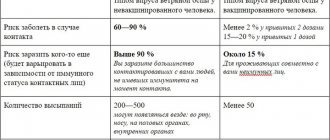Vaccine options
All modern vaccines for the prevention of viral hepatitis B are produced using genetic engineering technology.
A segment of the virus genome is introduced into the genetic material of baker's yeast, which is responsible for the production of the “Australian” (HBsAg) antigen. Vaccines consist of almost 90-95% antigen and only 5-10% of other components. The following vaccinations are used in Russia: “Vaccine against hepatitis B recombinant”, “Regevac V”, “Engerix V”, “Bubo-Kok”, “Bubo-M”, “Shanvak-V”, “Infanrix Hexa”, DPT-GEP B All of these vaccines are weakly reactogenic, interchangeable - that is, the course of vaccinations can be started with one vaccine and finished with another (although it is still preferable to vaccinate within the course with a vaccine from the same manufacturer). They are intended for vaccination of children and adults against hepatitis B.
The second, non-specific, but important component of vaccines is aluminum hydroxide. This substance is a so-called depositing agent in vaccinations and is designed to enhance the immune response. Its purpose is aimed not only at strengthening the immune response, but also at the dosed release of antigen from the site of hepatitis B vaccination. The need for it is dictated by the fact that, as a rule, vaccines based on only one antigen are weakly immunogenic, and in order to achieve the required levels of formed antibodies require either the introduction of more antigen or an increased response to it.
Hepatitis Vaccine Information
Vaccinations against the virus have been available since 1981. The first vaccines were made from donor plasma; during their use, cases of damage to the nervous system in patients were recorded, but assessment of the level of antibodies even 15 years after administration showed quite high results. The next generations of the vaccine were produced using genetic technologies with cultivation in yeast culture.
Composition of hepatitis vaccine
Modern drugs contain the surface antigen of the virus HBsAg. After vaccination, it can be detected in a person’s blood for several days, then the body begins to produce antibodies that protect against infection.
The general composition of the vaccines is as follows:
- HBsAg antigen,
- adjuvant (aluminum hydroxide),
- mercury-containing preservative (synonyms “thiomersal”, “thimerosal”);
- traces of yeast proteins.
Some series of vaccines do not contain a preservative.
The table below shows the main drugs available for purchase and used in the Russian Federation.
Table: Hepatitis B vaccines
| A drug | Manufacturer | Features of the vaccine |
| Infarix Hexa | GlaxoSmithKline Trading, made in Belgium or France | Multicomponent drug for the prevention of 6 infections: tetanus, diphtheria, whooping cough (acellular), polio (inactivated), combined hepatitis B, vaccine for the prevention of Haemophilus influenzae infection. The drug is used in children's practice, starting from the age of three months. |
| Engerix V | GlaxoSmithKline Trading, country of origin: Belgium | Hepatitis B vaccine, recombinant. It is used for children from the neonatal period and adults, available in two dosages (10 and 20 mcg of antigen). |
| Regevak B | JSC Binnopharm, country of origin: Russia | Hepatitis B vaccine, recombinant. Used for children from the neonatal period and adults, dosage for children and adults (10 and 20 mcg of antigen).). |
| Hepatitis B vaccine (recombinant) yeast | Combiotech NPK, country of origin: Russia | The vaccine is available in 2 dosages. |
Introduction Features
The hepatitis vaccine belongs to the inactivated group - it does not contain a live pathogen. Therefore, its simultaneous administration along with other agents is allowed. Injections are performed in different parts of the body, using a separate syringe for each vaccine.
The only drug that requires separation at an interval of at least 1 day is BCG (tuberculosis vaccination).
Where is the hepatitis vaccine given? According to the instructions, for children under 2 years old it is injected into the front of the thigh, for children over 2 years old and adults - into the deltoid muscle (outer surface of the shoulder, upper third). Other injection sites (subscapular, gluteal region) should not be chosen. If the vaccination was done incorrectly, it does not count; To form antibodies, the injection should be repeated soon.
Hepatitis B is a serious disease that often leads patients to death from cirrhosis or primary liver cancer. Children under one year of age are the population among whom the infection more often becomes chronic. Timely administration of the vaccine protects in 98-100% of cases. The hepatitis vaccine is well tolerated and has no age restrictions.
Principles and purposes of vaccination
About 780,000 people die every year from the consequences of hepatitis B. Vaccination is not only the main and important means of preventing viral hepatitis. It may also protect against primary liver cancer. The basis for preventing hepatitis B is the vaccine against this disease. WHO recommends that all infants should receive hepatitis B vaccination as soon as possible after birth, preferably within 24 hours. The dose given at birth should be followed by two or three subsequent doses to complete the vaccination series. In most cases, one of the following two options is considered optimal:
- a three-dose hepatitis B vaccination regimen, in which the first dose (of monovalent vaccine) is given at birth, and the second and third doses (of monovalent or combination vaccine) are given at the same time as the first and third doses of DPT vaccine;
- A four-dose regimen in which the first dose of monovalent vaccine given at birth is followed by 3 doses of monovalent or combination vaccine, usually given along with other vaccines as part of routine childhood immunization, is indicated for children born to mothers infected or with hepatitis B.
After a full series of vaccinations, more than 95% of infants, children of other age groups and young adults develop protective antibody levels. Protection lasts for at least 20 years and possibly a lifetime. All previously unvaccinated children and adolescents under 18 years of age should receive the vaccine if they live in countries with low or moderate endemicity. By the end of 2013, hepatitis B vaccine for infants had been introduced nationally in 183 countries. Global coverage of three doses of hepatitis B vaccine is estimated at 81%, and for Western Pacific countries it reaches 92%.
When can an adult get a hepatitis B vaccine?
You can get vaccinated against hepatitis B at any age. The immunization schedule is selected by the doctor.
Most often, patients are offered 3 vaccinations at a certain interval:
- first - at any time (in the absence of contraindications);
- the second - no earlier than 30 days after the first;
- the third - no earlier than 4 months after the first.
Vaccination against hepatitis B helps to develop immunity to the virus within the first weeks after the vaccine is administered.
Vaccine effectiveness
The vaccine is highly safe and effective. More than one billion doses of hepatitis B vaccine have been administered worldwide since 1982. In many countries where typically 8% to 15% of children had chronic hepatitis B virus infection, vaccination has helped reduce rates of chronic infection among immunized children to less than 1% .
After a course of immunization, sufficient immunity is developed in 90% of vaccinated people. Vaccinations can reduce the incidence of hepatitis by 30 times and prevent at least 85-90% of deaths due to this disease. In addition, the risk of getting sick in those born to mothers who are carriers of the infection is reduced by 20 times.
Many researchers call the hepatitis B vaccine the “first cancer vaccine” because it prevents the development of HBV infection, which ultimately leads to hepatocellular carcinoma.
Vaccine hepatitis B recombinant (rDNA)
Before use, the vial (ampoule) with the vaccine must be shaken well several times until a homogeneous suspension is obtained.
The vaccine is administered intramuscularly:
- for young children (1-2 years) - in the upper outer surface of the middle part of the thigh;
- adults, teenagers and older children (over 2 years old) - into the deltoid muscle.
For patients with bleeding disorders, the vaccine should be administered subcutaneously.
It is prohibited to administer the vaccine intravenously!
When administering the vaccine, you should make sure that the needle does not enter the vascular bed. The drug from an opened bottle with 10 doses of the vaccine must be stored at a temperature of 2-8 0 C and used within one day.
A single dose of the vaccine is:
— for children from 1 year old, teenagers and persons under 19 years old
- 0.5 ml (10 µg HBsAg);
— for persons over 19 years old
- 1 ml (20 µg HBsAg).
Vaccination against viral hepatitis B for persons not previously vaccinated and not at risk
, is carried out in accordance with the National calendar of preventive vaccinations of the Russian Federation and the calendar of preventive vaccinations for epidemic indications (Order of the Ministry of Health of Russia dated March 21, 2014 No. 125n) according to the 0-1-6 scheme (1st dose at the start of vaccination, 2nd dose - 1 month after the 1st dose, 3rd dose - 6 months after the 1st dose).
Children at risk
(born from mothers who are carriers of HBsAg, patients with viral hepatitis B or who have had viral hepatitis B in the third semester of pregnancy, who do not have test results for markers of hepatitis B, who consume narcotic drugs or psychotropic substances, from families in which there is a carrier of HBsAg or a patient with acute viral hepatitis B and chronic viral hepatitis) vaccination is carried out according to the 0-1-2-12 scheme (1st dose at the start of vaccination, 2nd dose 1 month after the 1st dose, 3rd dose after 2 months after the 1st dose, 4th dose - 12 months after the 1st dose).
Contact persons from the outbreaks of the disease who have not been sick, have not been vaccinated and do not have information about preventive vaccinations against viral hepatitis B are subject to vaccination according to the 0-1-6 scheme.
Vaccinations against hepatitis B according to the 0-1-6 scheme are also subject to:
- children and adults who regularly receive blood and its preparations;
— oncohematological patients;
- medical workers who have contact with the blood of patients;
— persons involved in the production of immunological preparations from donor and placental blood;
— students of medical institutes and students of secondary medical educational institutions (primarily graduates);
— persons who inject drugs.
Patients receiving hemodialysis treatment
, the vaccine is administered four times according to the scheme: 0-1-2-6 or 0-1-2-3 at a double age dose
Unvaccinated persons who have been exposed to hepatitis B virus-infected material should
vaccination is carried out according to the 0-1-2 scheme. Simultaneously with the first vaccination, it is recommended to administer intramuscularly (to another place) human immunoglobulin against hepatitis B at a dose of 100 IU (children under 10 years old) or 6-8 IU/kg (other ages).
Unvaccinated patients scheduled for surgery
, it is recommended to vaccinate according to the 0-7-21 day schedule one month before surgery.
Post-vaccination reactions
Modern vaccinations against hepatitis B are characterized by an extremely high degree of purification, up to 95% of their volume is represented by antigen. In addition, vaccinations consist of only one antigen, the content of which is measured in micrograms. Both of these factors determine that in practice these vaccines are among the safest, “mildest”, and easily tolerated.
The most typical post-vaccination reactions to hepatitis B vaccines are local reactions (ie, those occurring at the injection site). Their frequency is fairly standard for all available vaccines - up to 10% (maximum) of vaccinated people report symptoms such as redness, slight thickening, and discomfort during active movements. The prevalence of local reactions is explained by the action of aluminum hydroxide, a substance that is specifically designed to enhance the inflammatory reaction at the site of drug administration so that as many immunocompetent cells as possible come into contact with the injected antigen.
Much less frequently, with a frequency of about 1% (maximum - 5%), the so-called so-called general reactions, i.e. affecting the body as a whole - a slight increase in body temperature, mild malaise, etc. All of the above reactions are normal (expected), appear within 1-2 days from the moment of vaccination and disappear without treatment within 1-2 days.
Contraindications
The only specific and absolute contraindication for vaccines against the hepatitis B virus is an allergy to products containing baker's yeast. Temporary contraindications: severe reaction (temperature above 40oC, swelling, hyperemia > 8 cm in diameter at the injection site) or complication (exacerbation of chronic diseases) to the previous administration of the drug. Routine vaccination is postponed until the end of acute manifestations of the disease or exacerbation of chronic diseases. For mild ARIs, acute intestinal and other diseases, vaccinations can be carried out after the temperature has normalized.










